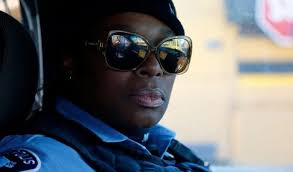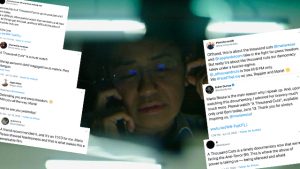 As a stopgap measure, the AFI Docs festival in Washington, DC was remarkably satisfying. The technology largely worked; most Zoom participants remembered to mute/unmute; the ticketing was efficient; Q&As were well-hosted and informative. Missing, of course, was the serendipity, the opportunities to catch up with colleagues, the information-sharing about can’t-miss films. But as virtual events go, this one was well-produced.
As a stopgap measure, the AFI Docs festival in Washington, DC was remarkably satisfying. The technology largely worked; most Zoom participants remembered to mute/unmute; the ticketing was efficient; Q&As were well-hosted and informative. Missing, of course, was the serendipity, the opportunities to catch up with colleagues, the information-sharing about can’t-miss films. But as virtual events go, this one was well-produced.
AFI Docs has demonstrated commitment to social-issue docs in a range of aesthetic modes and over a range of topics, appropriate to its DC venue. This year the showing was strong.
Truth and Power
 Perhaps the most top-of-headlines film was Dierdre Fishel’s work-in-progress (but close to finished) Women in Blue, an Independent Television Service (ITVS) film (Full disclosure: I serve on the board of ITVS). Shot between 2017-2019 in Minneapolis, it follows a female police chief in an ultimately failed attempt to introduce more women into the ranks and into leadership. The women characters are engaging, as the camera follows them through their days and into their homes. And we certainly empathize with their frustration and loss. At the same time, the youngest woman, a patrol officer, is already becoming cynical, understanding force as a first option. While the film is structured around the argument that having more women in policing could change the culture, it also contains plenty of evidence to reinforce the argument that policing as it currently is designed is not reformable.
Perhaps the most top-of-headlines film was Dierdre Fishel’s work-in-progress (but close to finished) Women in Blue, an Independent Television Service (ITVS) film (Full disclosure: I serve on the board of ITVS). Shot between 2017-2019 in Minneapolis, it follows a female police chief in an ultimately failed attempt to introduce more women into the ranks and into leadership. The women characters are engaging, as the camera follows them through their days and into their homes. And we certainly empathize with their frustration and loss. At the same time, the youngest woman, a patrol officer, is already becoming cynical, understanding force as a first option. While the film is structured around the argument that having more women in policing could change the culture, it also contains plenty of evidence to reinforce the argument that policing as it currently is designed is not reformable.

“A Thousand Cuts” found hundreds of thousands of viewers overnight in the Philippines, many of them astonished at what they had not known.
Also rivetingly topical is Ramona Diaz’ remarkable A Thousand Cuts, following the courageous investigative journalist Maria Ressa in the Philippines. Ressa’s publication Rappler has dared to tell the truth, which has put her and it into President Duterte’s crosshairs. In June, Ressa was sentenced to six years in prison for supposedly violating a law that hadn’t even been passed when the offending article was written (and not by her).
Diaz’ story is as much about Duterte’s authoritarian regime, which has floated on the river of blood generated by his “drug war,” as it is about Ressa. Duterte, a narcissistic and wantonly violent violator of the Philippine constitution, sustains support with the help of social-media entertainers, one of whom we meet up-close and personal. But he’s also drawing on a reservoir of crushing disappointment with government, ever since the end of the Marcos era.
Ressa gave the filmmaker extraordinary access, Diaz thinks, simply to create a record of what was happening. The portrait Diaz creates is of a brave, kind, fair and often funny person, who cares about her country. This powerful story of journalistic courage and authoritarian menace is notable among other things for its alarming resonance with the political situation in the US. As Ressa says, these techniques are pioneered in the developing countries that, like the Philippines, are former colonies: “What happens in the Philippines eventually comes to the US.” Like Ressa, director Ramona Diaz is a citizen of both the US and the Philippines. “The two countries I call home are coming to look the same, and that’s new for me,” Diaz told me. “When I saw a CNN reporter get arrested on TV, I asked myself, Wait, aren’t I in the United States?”
I saw the two-hour version, which kept me fully occupied; on August 7, you too can see it theatrically and on SVOD. And soon, PBS’ FRONTLINE viewers will be able to watch a slightly shorter version. Kudos to FRONTLINE’s Raney Aronson-Rath, who in 2017 showcased the Kartemquin Films Abacus (by Steve James), about the unjust prosecuting of a tiny Chinese-American consumer bank in the wake of the 2008 financial crash that principally involved mega-investment banks, and last year picked up For Sama, the extraordinary narrative of living under siege in Aleppo. These are bets on stories that can make a difference.
A Thousand Cuts has already made a difference in the Philippines. When the verdict came down for Ressa, FRONTLINE made the film available on YouTube in the Philippines for 24 hours. Nearly 250,000 people watched, Diaz told me. It was shocking news for many, since their press is effectively censored.
Election Drama

The many faces of Asian-American voters face off in “First Vote.”
Two fascinating films are must-watch for anyone who cares about the upcoming election (and if you’re not, really, check your pulse). Yi Chen’s First Vote, an ITVS film, is a vérité look at Chinese-American electoral organizing in North Carolina and Ohio. You’ll meet a gun-toting Chinese immigrant woman courting Tea Party votes; an approving GOPer beams as she calls her “one contagious Chinese cookie.” There’s a crisply-attired Chinese immigrant professor who won citizenship in order to vote for Trump; and a long-haired Chinese-American professor who decries the “lickspittles” who support what he sees as an openly white-supremacist agenda. This is storytelling from sectors some of us hadn’t even thought about. A clutch of small moments deftly reveal character and culture. Yi Chen, herself a Chinese immigrant, gained unparalleled access and never loses the thread. (Full disclosure: I taught Yi Chen when she got an MFA at American University.)

Rashida Tlalib draws on her community to win the primary for Congressional representative.
And She Could Be Next, by Grace Lee and Marjan Safinia, could make you actually get out and join an electoral campaign. The first episode follows six women—Arab-American, African-American and Latina—as they gear up for the 2018 election primary, in races that range from county commissioner to state legislature to governor to Congress. We meet their families, their supporters, and the people whose doors get knocked on; we become invested in their success, as we come to understand the long shot they are banking on. In defiance of everything we know about money, gerrymandering and disinformation, they’re living examples of grassroots democracy. And although we don’t see it in the first episode (which stops at the primary), some of them actually win and are currently in office. Watching this movie is a cleansing for your cynicism. Both episodes are currently streaming on POV, after having been backed by the Independent Television Service (ITVS) and the Corporation for Public Broadcasting’s minority consortia.
The Terms of Work
Workplace and labor documentaries are the hen’s teeth of festival programming, so it was exciting to see not one but two such documentaries at AFI Docs. Julia Reichert and Steve

Karen Nussbaum leads early organizing efforts for women admins.
Bognar’s 9to5 tells the story of the organizing that won women office workers basic respect in the workplace and, for a short while, a union of their own. (They are now often represented by SEIU, but not in their own sub-unit.) It gives you the impression of watching a living history; it’s easy to forget that it’s all archival and interviews.
Reichert and Bognar do not shy away from hard issues: racism of organizers in the workplace; the inexperience and naiveté of leaders; entrenched misogyny in the union movement. They also feature organizers of color, and interviewees recreate some vivid moments. For instance, organizer Karen Nussbaum recalls organizing sessions where women demanded restoration of free tampons in the restrooms, partly to see management squirm. “We had people knitting in the bargaining sessions, just to drive these guys crazy,” she remembers. The height of the “9 to 5” organizing movement collided rudely with the rise of neoliberalism, starting with the Reagan era and continuing through Bill Clinton. 9to5 adds richly to our historical memory of how people won the gains we often take for granted, and it also chronicles where organizing fails.

Children and families depend on 24/7 daycare in order to work the shifts that keep the family fed.
Extraordinary testimony to the cost of a sustained, brutally neoliberal economic policy is Loira Limbal’s ITVS-funded Through the Night. Nunu and Patrick, an African-American couple, run a 24-hour daycare center with love for the children, compassion for the parents, and dismay at the cruelty of the terms of daily life for both the kids and their (mostly) moms. We get to meet a couple of the moms whose children they care for; their choices are brutal. Work a 12-hour night shift, and try to stay awake enough during the day to care for your children. Work three jobs, none of which offer health care, and hope to get a moment with your kids. Nunu is everybody’s other mom, and Patrick is their dad. When Nuna suffers a health crisis, everyone is in trouble. Through the Night demonstrates how creatively people adapt to brutal circumstances, and also implicitly argues that they shouldn’t have to.
De-stigmatizing Female Desire
I learned something entirely new from Dilemma of Desire, by Kartemquin Films’ Maria Finitzo. If you already knew what the entire organ of the clitoris looks like, I commend you. For the rest of us, most of the first half of this film contains new news. Among other things,  we learned that you can take anatomy courses, buy anatomy books, graduate from med school and never find out even about the shape of this organ. And if you turn to the medical literature to learn anything about it, you won’t find much. We get to meet an artist who specializes in sculptures, stickies and posters featuring the clitoris. (One of her slogans: VIAGRA WON’T MAKE YOU CLITERATE.) We also meet a designer for a business that features Apple-sleek versions of vibrators that can also be worn as jewelry with no one the wiser. The company can’t use social media to advertise, because terms of service construe female desire as pornography.
we learned that you can take anatomy courses, buy anatomy books, graduate from med school and never find out even about the shape of this organ. And if you turn to the medical literature to learn anything about it, you won’t find much. We get to meet an artist who specializes in sculptures, stickies and posters featuring the clitoris. (One of her slogans: VIAGRA WON’T MAKE YOU CLITERATE.) We also meet a designer for a business that features Apple-sleek versions of vibrators that can also be worn as jewelry with no one the wiser. The company can’t use social media to advertise, because terms of service construe female desire as pornography.
The second half of the film explores why there is so much ignorance, so little research, and so much stigma around learning about the clitoris and female desire. Turns out—it’s not about the sex, it’s about the power. Discounting female desire and normalizing male desire works excellently to reinforce male dominance.
Dilemma of Desire, crisply edited by Liz Kaar to drive the argument for the legitimacy of female sexual desire, never stops surprising, either with its characters or its insights. I hope it generates a lot of conversation.
Get the Job Done
I also saw films that efficiently do the work. Shalini Kantayya’s Coded Bias makes accessible Cathy O’Neil’s important book Weapons of Math Destruction, in greater detail than O’Neil’s TED talk and with some flashy graphics. It showcases MIT researcher Joy Buolamwini, whose research shows bias baked into automated data processing systems. Basically, we live in a surveillance society, where both government and corporations have ungoverned access to patterns of our behavior that not even we are aware of. We need regulation.
Stockton on My Mind, by Marc Levin for HBO, profiles Stockton, California mayor Michael Tubbs as he tries out universal basic income and free college scholarships to improve the lives of residents whose entire social fabric has been frayed beyond survivability by neoliberal government. It’s a fascinating test case for what could, in some future political scenario, become policy.
Almost
If there were a category for Most Amazing Character in a Film That Is Not Quite Ready for Her, I would give it to the New Orleans trans musical performer Freedia, a pioneer of bounce music and star of her own TV series. Freedia Gets a Gun, by Chris McKim, is a shaggily edited story of Freedia’s attempt to raise awareness of the mortal peril of gun culture, which killed her brother. The film was produced by World of Wonder, which has the Ru Paul’s Drag Race franchise.
And if there were a Missed Opportunity category, I would give it to Daniel Lombroso’s White Noise, from The Atlantic. This doc features three well-known figures on the alt-right: Richard Spencer, Lauren Southern and Mike Cernovich. Although Lombroso had remarkable access to all three, we learn little that isn’t already available. They are all blowhards and hustlers, as the film makes clear, although this is also not news. They are not movement leaders, but social media celebrities. The careers of all three implode. We don’t get a sense of their followers—how big is the alt-right, how organized? What is the nature of the threat? It’s just not clear what their claim on our precious time is. Certainly President Trump does not need this version of the alt-right to make his brassy, daily case for white supremacy and authoritarianism, and to act on it with impunity. He has Congressional Republicans for that.
Legacy
The power of documentary’s past was also, commendably, on display at AFI Docs. Portraits and Dreams is both a documenting of the present and a recollection of the past. Filmmaker Elizabeth Barret, a stalwart of media arts center Appalshop in Whitesburg, Kentucky, and

What happened to the girl who took this self-portrait?
photographer Wendy Ewald, who 35 years before taught autobiographical photography to elementary school students in the same town, revisit those people now. A kind of 42 Up, the film gives us a multi-faceted look at Appalachian cultures through the stories youngsters told about themselves in photographs, and the way the adults they became see that work now. It’s a powerful statement about art and identity.
As well, AFI Docs brought back classics. Among them was a newly restored version of legendary African-American filmmaker William Greaves’ Nationtime—Gary. It’s a record of the 1972 National Black Political Convention, which brought together luminaries of that era’s civil rights movement. It features an electrifying speech by Jesse Jackson. In Q&A, Bryan Lewis, PR director for the event, said it was “the birth of Jesse Jackson.” Another legacy screening was Connie Field and Marilyn Mulford’s Freedom on My Mind (1994). It’s available on a variety of platforms; find it. It is too easy to forget what it took from Black and white activists to create even the possibility of voting for African-Americans. Some scenes still shock, showing that Black people were, effectively, enslaved in some areas of the US into the 1960s; some energize, with historic stories of Black leadership for human rights.
And the Guggenheim Symposium this year featured Lee Grant, now in her 90s. After a meteoric Hollywood ascent, she was blacklisted for 14 years. When she returned at the age of 36, she made award-winning social issue documentaries, including the 1986 Oscar winner Down and Out in America. In her interview with Washington Post critic Ann Hornaday, Grant described her gratitude to know the people who became the subjects of her films.
Public TV Matters
The Corporation for Public Broadcasting was, as usual, a sponsor, which gives public broadcasting a chance to shine. Several of the festival films with strong personal stories of disenfranchised people, and authorial voices of directors, were supported and/or showcased by, public broadcasting. These are the documentaries that give documentary its reputation for telling truth to power. Public broadcasting’s digital presence was given a tip of the hat by Charlotte Mangin and Sandra Rattley’s Unladylike 2020, which compiles several of the short episodes on American Masters’ online series of underrepresented women fighting for representation and rights.
CPB-sponsored discussions at the AFI Docs Forum also opened frank discussions about public TV’s relationships with indies. Talking about the role of public TV stations, which can be gateways to national distribution, Juan Devis of PMG SoCal talked about the problem of scale. It was usually impossible, he argued, for a single station to meet the financial needs for a stand-alone project. But if indies could brainstorm with a station to come up with a nationally-marketable idea—for instance, The Migrant Kitchen—then the numbers might work.
In a Forum conversation about staying safe while filming these days, FRONTLINE’s Raney Aronson-Rath argued for always preparing for the worst. She noted that many filming situations, even without a pandemic, can be dangerous. Both FRONTLINE staffers and freelancers are required to have complete protective gear before going on a shoot
